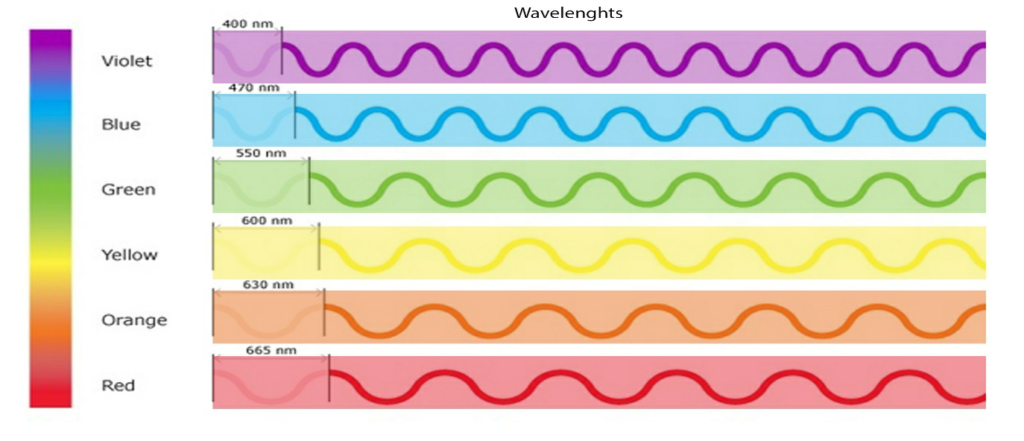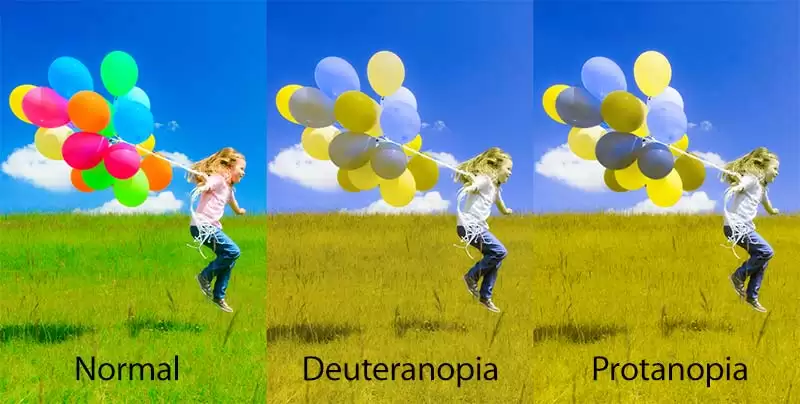What Color Are Best Seen From The Farthest Distance

We wake up, open our optics, and the journey begins. Every day, our optics experience a journey. They practise a significant job of bringing things into our vision. The understanding of how we perceive colors and recognize them would fascinate you. I will talk about the process of perceiving colors and also the most visible colors to our eyes. Then, let me fascinate you by explaining the process.
What you will see in this post:
- How Practise We Perceive Colors?
- The Cones: Responsible In Light
- The Rods: Responsible In the Dark
- Bananas Are Not Yellow
- Is Yellow I Of the Most Visible Colors To Eyes?
- The Most Visible Colors For Human Eyes!
- Red and orange? Most Visible Colors Likewise?!!
- Most Visible Colors From a Altitude
- So, What Are the Hardest Colors To See?
- Color Blindness
- Monochromacy
- Near Visible Colors Differ In Colorblindness Deficiencies!
- Rod monochromacy (achromatopsia)
- Cone monochromacy
- Dichromacy
- Protanopia
- Deuteranopia
- Tritanopia
- Dissonant trichromacy
- Protanomaly
- Deuteranomaly
- Tritanomaly
- conclusion
How Practice We Perceive Colors?
The part of the eyes that enables us to see colors is called "fovea centralis" at the back of our eyes. At that place are millions of light receptors called "cones and rods". These cones and rods react to light and tell our brains what colors we run into.
The "retina" is a role of the brain, and information technology'southward covered by millions of light-sensitive cells. Some of them are cones, and some are rods. Cones and rods are the receptors. They process the lite into nervus impulses and transmit them to the cortex of the brain through the "optic nerves".
The Cones: Responsible In Calorie-free
The cones are active in presence of more light and answer more than strongly to scarlet, green, and bluish. When we see colors, their light hits the cone cells and provokes them. They transport the message beyond to our brain via our "optic nerves", which process the data and tell us what color we're looking at.
Nearly, two/3 of the cones procedure longer wavelengths; that's why the homo eyes perceive more variations in warm colors than cooler ones.

The Rods: Responsible In the Dark
On the other manus, the rods are active in environments with lower lite. the rods mostly perceive black & white, that'southward why it's difficult to decide the color of objects at night, or in very dim lighting. Now, we know the niggling fellas that help united states of america see the world more than beautiful.
Each colour has a wavelength, and we only see the ones inside the visible spectrum. therefore, we don't see the colors that have wavelengths either less or more than the visible range. The homo eye and encephalon work together to translate lights into colors(through complicated processes). When we see light (color), the light receptors transmit the bulletin to our brain which results in the "sensation of colors".
Bananas Are Non Yellow
Is Yellowish One Of the Most Visible Colors To Eyes?
Human eyes nearly sensitively respond to light-green color, peaking effectually 555nm. Newton observed that colour isn't inherent in objects. the surface of an object reflects some colors and absorbs all the others. So, what we meet is a reflection of colors.
For example, bananas are non yellow. The surface of the banana reflects the wavelengths we see as yellow and absorbs all the other wavelengths.
Our optics react differently to colors. Seeing colors seems to have furnishings on us. Some colors can make us feel relaxed, and some disturbing. Colors similar light blue or light-green can stimulate calmness. On the other manus, colors similar yellow or white rather irritate.
The Most Visible Colors For Human being Optics!
Yellowish is too the most visible color in the darkness. That's one reason why taxis are often yellow. also, why yellow is used in caution signs. In the daylight, the about visible color is a wavelength of 550nm; a color betwixt green and yellow.
Our eyes grab cherry, orange, and yellowish the fastest. no wonder why! but are these the about attractive colors to our eyes too?
The respond tin can vary from person to person because people like different colors. only more often than not, red, orange, and yellow can exist agonizing to our eyes and sometimes cause headaches.


Ruby-red and orange? Most Visible Colors Also?!!
Every bit I said earlier, red and orange are too the near visible colors for man optics because of their sharpness our eyes distinguish them the fastest.

About colors
- Bright colors: the easiest to run into (high light reflection and more visible to our eyes)
- Solid, vivid colors (cerise, orange, and yellow): more than visible than pastels.
- Lighting Influences the color perception: dim light can "wash out" some colors, while bright low-cal can intensify others.
Well-nigh Visible Colors From a Distance
Do yous know what colors are more visible to see from far away?
As you know, lights have specific wavelengths, and these wavelengths put each calorie-free on a level that is either easy or hard to run into. Some wavelengths are easier for the homo eye to recognize. And some others are non.
In daylight, green is the most visible color from a distance for human eyes. In the darkness, however, yellow is the easiest color to recognize. The rods (modest structures in the eye) are responsible for sight in low-light situations. And the cons are responsible for loftier-light conditions. Therefore, rods help u.s. to see yellow in dark, and cones help us to see dark-green in the low-cal.

And so, What Are the Hardest Colors To See?
The short answer is Red. The red color is the hardest to see in the darkness. The cones recognize the color and send a message to our encephalon. So we tin encounter red color.
Fun fact:
What do y'all think of Red-Light-green and Yellow-Blue?
These are the pairs of colors that abolish each other. In the man eye, their light frequency instinctively neutralizes each other. Consequently, ruddy-green and yellowish-blueish are supposedly impossible to see at the same time.
Color Blindness
Monochromacy
As well known every bit "total color incomprehension", is the lack of ability to distinguish colors (and thus the person views everything as if it were on a black and white idiot box). the cone defect or absenteeism causes monochromacy. Monochromacy occurs when two or all three of the cone pigments are missing and color and lightness vision is reduced to one dimension. Accordingly, in monochromacy, the nigh visible colors are blackness and white.
Virtually Visible Colors Differ In Colorblindness Deficiencies!
Rod monochromacy (achromatopsia)
Is an exceedingly rare, not-progressive disability to distinguish any colors. and information technology's a result of absent or non-performance retinal cones. It is associated with light sensitivity (photophobia), involuntary heart oscillations (nystagmus), and poor vision.

Cone monochromacy
Is a type of rare total color blindness that is accompanied by relatively normal vision, electroretinogram, and electrooculogram. Cone monochromacy can as well be a result of having more than one type of dichromatic color blindness. colorblind persons who have, for instance, both protanopia and tritanopia are considered to have cone monochromacy. Since cone monochromacy is the lack of / damage of more than one cone in the retinal surround, having two types of dichromacy would be equivalent.

Dichromacy
Is hereditary. Protanopia and deuteranopia are hereditary and sex-linked, affecting predominantly males.
Protanopia
The complete absence of carmine retinal photoreceptors causes Protanopia. Protans have difficulties distinguishing between blueish and green colors and also betwixt red and green colors. Information technology's a form of dichromatism; in which the subject tin but perceive calorie-free wavelengths from 400 nm to 650 nm, instead of the usual 700 nm. In this type, the person cannot see pure reds and sees them as black. the person also, can't distinguish purples from blues. more orange-tinted reds may announced as dim yellows, and all orange–yellow–light-green shades of too long a wavelength to stimulate the blue receptors to appear equally a similar yellow hue. It occurs in 1% of males.

Deuteranopia
Affects hue discrimination in a similar manner to protanopia, but without the dimming event. information technology's also called red–greenish color blindness. Again, around i% of the male population suffers from this type of colorblindness.
Tritanopia
Is a very rare color vision disturbance in which only the red and the green cone pigments are present, with a total absence of bluish retinal receptors. it's also called blue–yellow colour incomprehension. Blues appear greenish, yellows and oranges appear pinkish, and purple colors appear deep red. Information technology's related to chromosome 7; thus unlike protanopia and deuteranopia, tritanopia and tritanomaly are not sex-linked traits, and they can be acquired rather than inherited and can be reversed in some cases.
Dissonant trichromacy
Is a common type of inherited color vision deficiency, occurring when one of the 3 cone pigments is altered in its spectral sensitivity.
Protanomaly
Is a mild color vision defect in which an altered spectral sensitivity of ruby-red retinal receptors (closer to green receptor response) results in poor ruby–green hue discrimination. Information technology is hereditary, sex-linked, and present in i% of males. In dissimilarity to other defects, in this instance, the L‑cone is nowadays but malfunctioning, whereas in protanopia the 50‑cone is completely missing.
Deuteranomaly
A similar shift in the green retinal receptors causes Deuteranomaly. and it is by far the most common blazon of color vision deficiency, mildly affecting red–green hue discrimination in 5% of European males. It is hereditary and sex-linked. In dissimilarity to deuteranopia, the green-sensitive cones are not missing but malfunctioning.

Tritanomaly
Is a rare, hereditary color vision deficiency affecting blue–dark-green and yellow–red/pink hue discrimination. It is related to chromosome 7.[19] In dissimilarity to tritanopia, the Due south‑cone is malfunctioning only non missing.[20]
Around 8% of men and 1% of women have some form of colour impairment. Most people with color deficiencies don't know that the colors they perceive as identical, are dissimilar from others. Most yet perceive color, but some colors are transmitted differently to the brain.
The nearly common damage is red and green dichromatism which causes ruby and greenish to announced duplicate. Merely people with full colour incomprehension are deficient.
In all these types of colour vision deficiencies, the nearly visible colour for the eyes differs based on the kind of colour incomprehension.

Color spectrum has three additive primary colors:
- Crimson
- Green
- Blue
By combining a sure corporeality of these colors, you tin take pure white. you tin can brand all the other colors in the visible spectrum by varying the amount of red, dark-green, and blue.
determination
Our optics function from the morning we wake up until we go to slumber at night, and they do intricate processes to enable us to see objects and colors. They're one of the most active and sensitive organs of our body. therefore, we need to accept practiced care of them. and so, take intendance of your dear eyes.
To read more than about colors y'all can visit our blog where everything is most colors
Hope you enjoyed information technology!
What Color Are Best Seen From The Farthest Distance,
Source: https://colors.dopely.top/inside-colors/the-most-visible-colors-for-human-eyes/
Posted by: duongparturly.blogspot.com


0 Response to "What Color Are Best Seen From The Farthest Distance"
Post a Comment